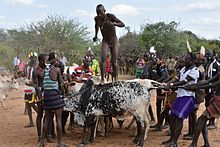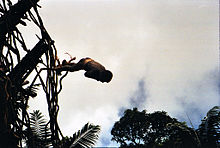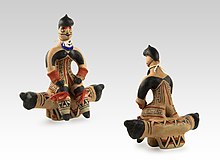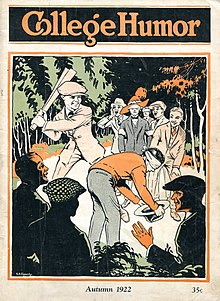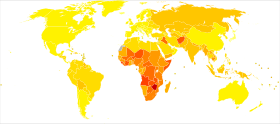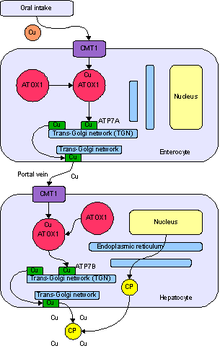From Wikipedia, the free encyclopedia
Hazing (American English), initiation, beasting (British English), bastardisation (Australian English), ragging (South Asian English) or deposition
refers to any activity expected of someone in joining or participating
in a group that humiliates, degrades, abuses, or endangers them
regardless of a person's willingness to participate.
Hazing is seen in many different types of social groups, including gangs, sports teams, schools, cliques, universities, military units, prisons and fraternities and sororities.
The initiation rites can range from relatively benign pranks to
protracted patterns of behavior that rise to the level of abuse or
criminal misconduct. Hazing is often prohibited by law or institutions such as colleges and universities because it may include either physical or psychological abuse, such as humiliation, nudity, or sexual abuse.
Terms
In some languages, terms with a religious theme or etymology are preferred, such as baptism or purgatory (e.g. baptême in Belgian French, doop in Belgian Dutch, chrzciny in Polish) or variations on a theme of naïveté and the rite of passage such as a derivation from a term for freshman, for example bizutage in European French, ontgroening ("de-green[horn]ing") in Dutch and Afrikaans (South Africa and Namibia), novatada in Spanish, from novato, meaning newcomer or rookie or a combination of both, such as in the Finnish mopokaste (literally "moped baptism"). In Latvian, the word iesvētības, which literally means "in-blessings", is used, also standing for religious rites of passage, especially confirmation. In Swedish, the term used is nollning, literally "zeroing". In Portugal, the term praxe, which literally means "practice" or "habit", is used for initiation. In Brazil, it is called trote and is usually practiced at universities by older students (doutores and veteranos) against newcomers (calouros) in the first week of their first semester. In the Italian military, instead, the term used was nonnismo, from nonno
(literally "grandfather"), a jargon term used for the soldiers who had
already served for most of their draft period. A similar equivalent term
exists in the Russian military, where a hazing phenomenon known as dedovshchina (дедовщи́на)
exists, meaning roughly "grandfather" or the slang term "gramps"
(referring to the senior corps of soldiers in their final year of conscription).
At education establishments in India, Pakistan, Bangladesh and Sri
Lanka, this practice involves existing students baiting new students and
is called ragging. In Polish schools, hazing is known as kocenie (literally catting, coming from the noun kot cat)[citation needed]. It often features cat-related activities, like competitive milk drinking. Other popular tasks include measuring a long distance (i.e. hallways) with matches. Less loaded names for hazing are otrzęsiny (related to the verb otrząsać get over, rally but also shake off/out—as being a novice is a negative state that should be quit) and chrzciny mentioned above.
Hazings are sometimes concentrated in a single session, which may be called a hell night, prolonged to a hell week, or over a long period, resembling fagging. When done on a persons birthday, it can be called birthday spanking.
Methods
One way of initiating a new member into a street gang is for multiple other members of the gang to assault the new member with a beating.
Hazing activities can involve forms of ridicule and humiliation
within the group or in public, while other hazing incidents are akin to
pranks. A snipe hunt
is such a prank, when a newcomer or credulous person is given an
impossible task. Examples of snipe hunts include being sent to find a
tin of Tartan paint, or a "dough repair kit" in a bakery, while in the early 1900s rookies in the Canadian military were ordered to obtain a "brass magnet" when brass is not magnetic.
Spanking is done mainly in the form of paddling
among fraternities, sororities and similar clubs, sometimes over a lap,
a knee, furniture or a pillow, but mostly with the victim "assuming the
position", i.e., simply bending over forward. A variation of this (also as punishment) is trading licks. This practice is also used in the military. Alternative modes (including bare-buttock paddling, strapping and switching, as well as mock forms of antiquated forms of physical punishments such as stocks, walking the plank and running the gauntlet) have been reported.
The hazee may be humiliated by being hosed or by sprinkler or
buckets; covered with dirt or with (sometimes rotten) food, even
urinated upon. Olive or baby oil
may be used to "show off" the bare skin, for wrestling or just
slipperiness, e.g., to complicate pole climbing. Cleaning may be limited
to a dive into water, hosing down or even paddling the worst off. They
may have to do tedious cleaning including swabbing the decks or cleaning
the toilets with a toothbrush. In fraternities, pledges often must
clean up a mess intentionally made by brothers which can include fecal
matter, urine, and dead animals.
Servitude such as waiting on others (as at fraternity parties) or
various other forms of housework may be involved, often with tests of
obedience. In some cases, the hazee may be made to eat raw eggs,
peppers, hot sauce, or drink too much alcohol. Some hazing even includes
eating or drinking vile things such as bugs or rotting food.
The hazee may have to wear an imposed piece of clothing, outfit, item
or something else worn by the victim in a way that would bring negative
attention to the wearer. Examples include a uniform (e.g. toga); a leash or collar (also associated with bondage); infantile and other humiliating dress and attire.
Markings may also be made on clothing or bare skin. They are
painted, written, tattooed or shaved on, sometimes collectively forming a
message (one letter, syllable or word on each pledge) or may receive tarring and feathering (or rather a mock version using some glue) or branding.
Submission to senior members of the group is common. Abject
"etiquette" required of pledges or subordinates may include prostration,
kneeling, literal groveling, and kissing body parts.
Other physical feats may be required, such as calisthenics and other physical tests, such as mud wrestling, forming a human pyramid, or climbing a greased pole. Exposure to the elements may be required, such as swimming or diving in cold water or snow.
Orientation tests may be held, such as abandoning pledges without
transport. Dares include jumping from some height, stealing from police
or rival teams and obedience. Blood pinning
among military aviators (and many other elite groups) to celebrate
becoming new pilots is done by piercing their chests with the sharp pins
of aviator wings.
On a pilot's first solo flight,
they are often drenched with water, as well as having the back of their
shirt cut off to celebrate the achievement. Cutting off the back of the
shirt originates from the days of tandem trainers, where the instructor
sat behind the student and tugged on the back of their shirt in order
to get their attention. Cutting off the back of the shirt symbolizes
that the instructor has no need to do that anymore.
On their first crossing the equator
in military and commercial navigation, each "pollywog" is subjected to a
series of tests usually including running or crawling a gauntlet of
abuse and various scenes supposedly situated at King Neptune's court. A pledge auction is a variation on the slave auction, where people bid on the paraded pledges.
Hazing also occurs for apprentices in some trades. In printing, it consists of applying bronze blue to the apprentice's penis and testicles,
a color made by mixing black printers ink and dark blue printers ink,
which takes a long time to wash off. Similarly, mechanics get their
groins smeared with old dirty grease.
Hazing by women of their suitors, often assisted by the women's
friends, can also play a role in budding romantic relationships, usually
taking mental and psychological rather than physical forms, and
apparently for the same basic purposes as other hazing.
Psychology, sociology, purpose and effects
Hazing supposedly serves a deliberate purpose of building solidarity. Psychologist Robert Cialdini
uses the framework of consistency and commitment to explain the
phenomenon of hazing and the vigor and zeal to which practitioners of
hazing persist in and defend these activities even when they are made
illegal.
Cialdini cites a 1959 study in which the researchers observed that
"persons who go through a great deal of trouble or pain to attain
something tend to value it more highly than persons who attain the same
thing with a minimum of effort". The 1959 study shaped the development of cognitive dissonance theory by Leon Festinger.
There are several psychological effects that both the hazer and
hazee endure throughout the hazing process. In an article published by
Raalte, Cornelius, Linder, and Brewer, the researchers used sports teams
as the subject of their study. The authors suggest that hazing can
result in some positive outcomes. During the hazing process, a bond
between the two parties (the hazer and the hazee) grew.
Many people view hazing as an effective way to teach respect and
develop discipline and loyalty within the group, and believe that hazing
is a necessary component of initiation rites.
Hazing can be used as a way to engender conformity within a social
group, something that can be seen in many sociological studies. Moreover, initiation rituals when managed effectively can serve to build team cohesion and improve team performance, while negative and detrimental forms of hazing alienate and disparage individuals.
Dissonance can produce feelings of group attraction or social identity among initiates after the hazing experience because they want to justify the effort used. Rewards during initiations or hazing rituals matter in that initiates who feel more rewarded express stronger group identity. As well as increasing group attraction, hazing can produce conformity among new members. Hazing could also increase feelings of affiliation because of the stressful nature of the hazing experience.
Also, hazing has a hard time of being extinguished by those who saw it
to be potentially dangerous like administration in education or law
enforcement. In an article published by Linda Wilson, she and the National Pan-Hellenic Council
Leaders at North Carolina Agricultural and Technical State University
gave their perspectives and opinions on hazing at their institution, and
she discussed why hazing is so hard to discontinue. The reason why is
because the act of hazing is deeply rooted traditionally, so it becomes
hard to break those traditional actions.
For example, York College in Pennsylvania tried to solve this issue
with suspending students who partake in the act. However, it is hard to
dismantle not only because of tradition, but also because it is meant to
be done in private spaces. It is not meant to be public which makes
getting rid of it even harder.
A 2014 paper by Harvey Whitehouse discusses theories that hazing can cause social cohesion though group identification and identity fusion. A 2017 study published in Scientific Reports found that groups that share painful or strong negative experiences can cause visceral bonding, and pro-group behavior. Students of Brazilian Jiu Jitsu who had experienced painful belt-whipping gauntlets had a higher willingness to donate time or risk their lives for the club.
Scope
United States
According to one of the largest US National Surveys regarding hazing
including over 60,000 student athletes from 2,400 colleges and
universities:
Over 325,000 athletes at more than
1,000 National Collegiate Athletic Association schools in the US
participated in intercollegiate sports during 1998–99. Of these
athletes:
- More than a quarter of a million experienced some form of hazing to join a college athletic team.
- One in five was subjected to unacceptable and potentially illegal
hazing. They were kidnapped, beaten or tied up and abandoned. They were
also forced to commit crimes – destroying property, making prank phone
calls or harassing others.
- Half were required to participate in drinking contests or alcohol-related hazing.
- Two in five consumed alcohol on recruitment visits even before enrolling.
- Two-thirds were subjected to humiliating hazing, such as being
yelled or sworn at, forced to wear embarrassing clothing (if any
clothing at all) or forced to deprive themselves of sleep, food or
personal hygiene.
- One in five participated exclusively in positive initiations, such as team trips or ropes courses.
The survey found that 79% of college athletes experienced some form
of hazing to join their team, yet 60% of the student-athletes
respondents indicated that they would not report incidents of hazing.
A 2007 survey at American colleges found 55% of students in
"clubs, teams, and organizations" experienced behavior the survey
defined as hazing, including in varsity athletics and Greek-letter organizations.
This survey found 47% of respondents experienced hazing before college,
and in 25% of hazing cases, school staff were aware of the activity.
90% of students who experienced behavior the researchers defined as
hazing did not consider themselves to have been hazed, and 95% of those
who experienced what they themselves defined as hazing did not report
it. The most common hazing-related activities reported in student groups
included alcohol consumption, humiliation, isolation, sleep
deprivation, and sex acts.
Police forces, especially those with a paramilitary tradition, or sub-units of police forces such as tactical teams, may also have hazing rituals. Rescue services, such as lifeguards or air-sea rescue teams may have hazing rituals.
Belgium
Hazing rituals are a common practice in student clubs (fraternities and sororities, called studentenclubs) and student societies (called studentenverenigingen, studentenkringen or faculteitskringen).
The latter is attached to the faculty of the university, while the
first ones are privately operated. Hazing rituals in student societies
have generally been safer than those in student clubs, precisely because
they are to some extent regulated by universities.
For example, KU Leuven drew up a hazing charter in 2013 following an animal cruelty incident in the hazing ritual of student club Reuzegom.
The charter was to be signed by student societies, fraternities and
sororities. Signing the charter would have been a pledge to notify the
city of the place and time of the hazing ceremony, and to abstain from
violence, racism, extortion, bullying, sexual assault, discrimination,
and the use of vertebrate animals. Reuzegom, as well as the other
fraternities and sororities of the Antwerp Guild, refused. In 2018,
twenty-year-old student Sanda Dia died from multiple organ failure in
the Reuzegom hazing ritual as a result of racially motivated abuse by
fellow Reuzegom members. As of 2019,
a few sororities have signed the charter, as well as all student
societies. In April 2019, the 28 remaining fraternities in Leuven signed
the charter.
Netherlands
In
the Netherlands, the so-called 'traditional fraternities' have an
introduction time which includes hazing rituals. The pledges go for a
few days to a camp during which they undergo hazing rituals but are
meanwhile introduced in the traditions of the fraternity. After camp,
there are usually evenings or whole days in which the pledges have to be
present at the fraternity, although slowly the pressure is released and
the relations become somewhat more equal. Often, pledges collect or
perform chores to raise funds for charity. At the end of the hazing
period, the inauguration of the new members take place.
Incidents have occurred resulting in injuries and death. Often
these incidents occur when members wish to join a house, (prestigious)
sub-structure or commission for which they undergo a second (and usually
heavier) hazing ritual. Incidents mostly occur during hazing rituals
for these sub-structures, since there is less or no control from the
fraternity board. Also, these sub-structure hazing rituals involve often
excessive alcohol abuse, even when alcohol has become a taboo in hazing
of the fraternity itself. Other situations causing additional risks for
incidents are members (often joining the hazing camp but not designated
with any responsibility) separating pledges and taking them away from
the main group to 'amuse themselves' with them.
In 1965 a student at Utrecht University choked to death during a hazing ritual (Roetkapaffaire). There was public outrage when the perpetrators were convicted to light conditional sentences while left-wing Provo
demonstrators were given unconditional prison sentences for order
disturbances. The fact that the magistrates handling the case were all
alumni of the same fraternity gave rise to accusions of nepotism and
class justice. Two incidents in 1997, leading to one heavy injury and
one death, lead to sharpened scrutiny over hazing. Hazing incidents have
nevertheless occurred since, but justice is becoming keener in
persecuting perpetrators.
The Netherlands has no anti-hazing legislation. Hazing incidents
can be handled by internal resolution by the fraternity itself (the
lightest cases), and via the criminal justice system as assault or in case of death negligent homicide or manslaughter.
Universities as a rule support student unions (financially and by
granting board members of such union a discount on the required number
of ECTS credits) but can in the most extreme case suspend or withdraw
recognition and support for such union.
Philippines
According to R. Dayao, hazing, usually in initiation rites of fraternities, has a long history in the Philippines,
and has been a source of public controversy after many cases that
resulted to death of the neophyte. The first recorded death due to
hazing in the Philippines was recorded in 1954, with the death of
Gonzalo Mariano Albert. Hazing was regulated under the Anti-Hazing Act of 1995,
after the death of Leonardo Villa in 1991, but many cases, usually
causing severe injury or death, continued even after it was enacted, the
latest involving Darwin Dormitorio, a 20-year old Cadet 4th Class from the Philippine Military Academy.
Republic of Ireland
Hazing incidents are rare in the Republic of Ireland, but are known at certain elite educational institutions.
At Trinity College Dublin,
an all-male society, Knights of the Campanile, was implicated in a
hazing incident in 2019, where initiates were required to eat large
amounts of butter. Campus newspaper The University Times was criticised for using secret recording devices to record the event. Dublin University Boat Club are also known for hazing, with rituals including consumption of alcohol, stripping to ones underwear, caning with bamboo
rods, push-ups, being shouted at, standing in the rain, being tied
together by shoelaces and crawling a maze while being hit with pillows. Hazing is common at Trinity sports societies and teams. Zeta Psi fraternity has a presence at Trinity as well, and some hazing has been reported.
Hazing also took place at Dublin City University's
Accounting & Finance Society in 2018, where first-years standing
for committee positions had to complete a variety of sexualised games.
The club was suspended for a year as a result.
A report on Gaelic games county players noted that 6% of players reported were aware of forced binge drinking as a form of hazing.
Ragging in South Asia
Ragging is a practice similar to hazing in educational institutions in the Indo subcontinent. The word is mainly used in India, Pakistan, Bangladesh and Sri Lanka. Ragging involves existing students baiting or bullying new students. It often takes a malignant form wherein the newcomers may be subjected to psychological or physical torture.
In 2009 the University Grants Commission of India imposed regulations upon Indian universities to help curb ragging, and launched a toll-free 'anti ragging helpline'.
The effectiveness of these measures are unknown; many accused of
ragging freshmen are either let out with a warning or saved from legal
action by political or caste lobbyists.
Although ragging is a criminal offense in Sri Lanka under the
Prohibition of Ragging and other Forms of Violence in Educational
institutions Act, No. 20 of 1998 and carries a severe punishment,
several variations of ragging can be observed in universities around
the country. Through the years this practice has worsened to all types
of violence including sexual violence, harassment and has also claimed
the lives of several students.
The university grants commission of Sri Lanka, have set up several
pathways to report ragging incidents, including a special office,
helpline and a mobile app where students can make a complaint
anonymously or seek help.
Controversy
The practice of ritual abuse among social groups is not clearly
understood. This is partly due to the secretive nature of the
activities, especially within collegiate fraternities and sororities,
and in part a result of long-term acceptance of hazing. Thus, it has
been difficult for researchers to agree on the underlying social and
psychological mechanisms that perpetuate hazing. In military circles
hazing is sometimes assumed to test recruits under situations of stress
and hostility. Although in no way a recreation of combat, hazing does
put people into stressful situations that they are unable to control,
which allegedly should weed out the weaker members before being put in
situations where failure to perform will cost lives. A portion of the
military training course known as Survival, Evasion, Resistance and Escape (SERE) simulates as closely as is feasible the physical and psychological conditions of a POW camp.
The problem with this approach, according to opponents, is that the stress and hostility comes from inside the group, and not from outside
as in actual combat situation, creating suspicion and distrust towards
the superiors and comrades-in-arms. Willing participants may be
motivated by a desire to prove to senior soldiers their stability in
future combat situations, making the unit more secure, but blatantly
brutal hazing can in fact produce negative results, making the units
more prone to break, desert or mutiny than those without hazing
traditions, as observed in the Russian army in Chechnya, where units with the strongest traditions of dedovschina were the first to break and desert under enemy fire. At worst, hazing may lead into fragging
incidents. Colleges and universities sometimes avoid publicizing hazing
incidents for fear of damaging institutional reputations or incurring
financial liability to victims.
In a 1999 study, a survey of 3,293 collegiate athletes, coaches,
athletic directors and deans found a variety of approaches to prevent
hazing, including strong disciplinary and corrective measures for known
cases, implementation of athletic, behavioral, and academic standards
guiding recruitment; provisions for alternative bonding and recognition
events for teams to prevent hazing; and law enforcement involvement in
monitoring, investigating, and prosecuting hazing incidents.
Hoover's research suggested half of all college athletes are involved
in alcohol-related hazing incidents, while one in five are involved in
potentially illegal hazing incidents. Only another one in five was
involved in what Hoover described as positive initiation events, such as
taking team trips or running obstacle courses.
Hoover wrote: "Athletes most at risk for any kind of hazing for
college sports were men; non-Greek members; and either swimmers, divers,
soccer players, or lacrosse players. The campuses where hazing was most
likely to occur were primarily in eastern or southern states with no
anti-hazing laws. The campuses were rural, residential, and had Greek
systems."
(Hoover uses the term "Greek" to refer to U.S.-style fraternities and
sororities.) Hoover found that non-fraternity members were most at risk
of hazing, and that football players are most at risk of potentially
dangerous or illegal hazing. In the May issue of the American Journal of Emergency Medicine,
Michelle Finkel reported that hazing injuries are often not recognized
for their true cause in emergency medical centers. The doctor said
hazing victims sometimes hide the real cause of injuries out of shame or
to protect those who caused the harm. In protecting their abusers,
hazing victims can be compared with victims of domestic violence, Finkel
wrote.
Finkel cites hazing incidents including "beating or kicking to the point of traumatic injury or death, burning or branding, excessive calisthenics,
being forced to eat unpleasant substances, and psychological or sexual
abuse of both males and females". Reported coerced sexual activity is
sometimes considered "horseplay" rather than rape, she wrote. Finkel quoted from Hank Nuwer's book "Wrongs of Passage" which counted 56 hazing deaths between 1970 and 1999.
In November 2005, controversy arose over a video showing Royal Marines
fighting naked and intoxicated as part of a hazing ritual. The fight
culminated with one soldier receiving a kick to the face, rendering him
unconscious. The victim, according to the BBC, said "It's just Marine humour".
The Marine who leaked the video said "The guy laid out was inches from
being dead." Under further investigation, the Marines had just returned
from a six-month tour of Iraq, and were in their "cooling down" period,
in which they spend two weeks at a naval base before they are allowed
back into society. The man who suffered the kick to the head did not
press charges.
In 2008, a national hazing study was conducted by Dr Elizabeth
Allan and Dr Mary Madden from the University of Maine. This
investigation is the most comprehensive study of hazing to date and
includes survey responses from more than 11,000 undergraduate students
at 53 colleges and universities in different regions of the U.S. and
interviews with more than 300 students and staff at 18 of these
campuses. Through the vision and efforts of many, this study fills a
major gap in the research and extends the breadth and depth of knowledge
and understanding about hazing. Ten initial findings are described in
the report, Hazing in View: College Students at Risk. These include:
- More than half of college students involved in clubs, teams, and organizations experience hazing.
- Nearly half (47%) of students have experienced hazing before coming to college.
- Alcohol consumption, humiliation, isolation, sleep deprivation, and sex acts are hazing practices common across student groups.
